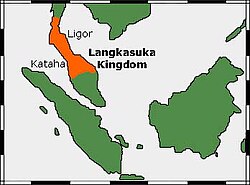
https://app.dsta.gov.sg/Dashboard.aspx
Langkasuka was an ancient Malay (Hindu-Buddhist) kingdom located in the Malay Peninsula.[1] The name is Sanskrit in origin; it is thought to be a combination of langkha for "resplendent land" -sukkha for "bliss". The kingdom, along with Old Kedah, is probably among the earliest kingdoms founded on the Malay Peninsula. The exact location of the kingdom is of some debate, but archaeological discoveries at Yarang near Pattani, Thailand suggest a probable location. The kingdom is believed to have been founded in the 2nd century.
According to the legend given in the Kedah Annals, the kingdom was founded and named by Merong Mahawangsa. Another proposal suggests that the name may have been derived from langkha and Ashoka, the legendary Mauryan Hindu warrior king who eventually became a pacifist after embracing the ideals espoused in Buddhism, and that the early Indian colonizers of the Malay Isthmus named the kingdom Langkasuka in his honour.[2] Chinese historical sources provided some information on the kingdom and recorded a king Bhagadatta who sent envoys to the Chinese court.
Historical records
The earliest and most detailed description of the kingdom comes from the Chinese Liang Dynasty (502-557) record Liangshu, which refers to the kingdom of "Lang-ya-xiu" (Chinese: 狼牙脩, Lang-gga-siu in Hokkien) founded in the 2nd century AD. According to Liangshu, "Lang-ya-xiu" or Langkasuka was thirty days' journey from east to west, and twenty from north to south, 24,000 li in distance from Guangzhou. It mentions that Aloeswood (Aquilaria) and camphor were abundant in the kingdom, and its capital was described as being surrounded by walls to form a city with double gates, towers and pavilions. Both men and women in Langkasuka wore sarongs with their torsos bare and their hair loose, although the king and senior officials covered their shoulders with cloth and wore gold earrings and belts of gold cord. Women of high status wrapped themselves in cloth and wore jeweled girdles.[3] It gives further information on some of its kings and also relates a story on a succession:
This king then ruled for more than 20 years. He was succeeded by his son, King Bhagadatta, who sent the first ambassadorial mission to China in 515.[6][7] Further emissaries were sent in 523, 531, and 568.[8]When the king goes forth he rides upon an elephant. He is accompanied by banners, fly-whisks, flags and drums and he is shaded with a white parasol. The soldiers of his guard are well-appointed. The inhabitants of the country say that their state was founded more than four hundred years ago. Subsequently the descendants became weaker, but in the king's household there was a man of virtue to whom the populace turned. When the king heard of this he imprisoned this man, but his chains snapped unaccountably. The king took him for a supernatural being and, not daring to injure him, exiled him from the country, whereupon he fled to India. The king of India gave him his eldest daughter in marriage. Not long afterwards, when the king of Lang-ya died, the chief ministers welcomed back the exile and made him king.
— Liangshu, translation by Paul Wheatley[4][5]
The transcription of the kingdom's name in Chinese records changed over time. In the late seventh century, the Buddhist monk Yi Jing mentioned encountering three Chinese monks who lived in a place named Lang-jia-shu (郎伽戍).[6]
A Song Dynasty work Zhu fan zhi (published in 1225) gives a description of the country of Ling-ya-si-jia (凌牙斯加). It mentions that its people cut their hair and wrapped themselves in a piece of cloth, its products included elephant tusks, rhinoceros horns, types of wood and camphor, and their merchants traded in wine, rice, silk and porcelain. It also says that the country paid tribute to a country named Sanfoqi which is often interpreted to be Srivijaya.[9][10]
Langkasuka was known as "Long-ya-xi-jiao" (龍牙犀角) in Daoyi Zhilüe from the Yuan Dynasty (1279–1368);[11] and "Lang-xi-jia" (狼西加) during the Ming Dynasty (1368–1644), as marked in the Mao Kun map of Admiral Zheng He .[12] Daoyi Zhilüe mentions that the native of Langkasuka make salt from seawater and ferment rice wine, and produced hornbill casques, lakawood, honey and gharuwood.[13] The people wore cotton from the Philippines and printed cloth from India and local sources.[14]
"Langkasuka" was mentioned in the Malay text Hikayat Merong Mahawangsa, and it was referred to as "Lengkasuka" in the Javanese poem Nagarakretagama.[1] Tamil sources name "Ilangasoka" as one of Rajendra Chola's conquests in his expedition against the Srivijaya empire. It was described as a kingdom that was "undaunted in fierce battles". Thai sources made no reference to Langkasuka, but Pattani was identified as one of the twelve Naksat cities under the influence of Nakhon Si Thammarat in Thai chronicles.[15]
Outline of Langkasuka's history[edit]
A brief outline of the history of Langkasuka can be determined from the limited historical records available. The kingdom is thought to have been founded some time early in the 2nd century AD. It then underwent a period of decline due to the expansion of Funan in the early 3rd century. In the 6th century it experienced a resurgence and began to send emissaries to China. King Bhagadatta first established relations with China in 515 AD, with further embassies sent in 523, 531 and 568.[6] By the 8th century it had probably come under the control of the rising Srivijaya empire.[16] In 1025 it was attacked by the armies of King Rajendra Chola in his campaign against Srivijaya. In the 12th century Langkasuka was a tributary to Srivijaya, and around the 15th century it was replaced by the Pattani Kingdom.
